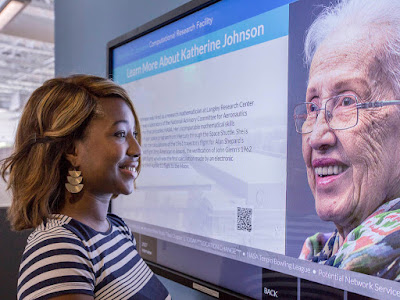 |
| Image Source: NASA link below |
Topics: African Americans, History, Diversity, Diversity in Science, NASA, Women in Science
When Jasmine Byrd started her job at NASA about two years ago, she knew nothing about Katherine Johnson, the mathematician and “human computer” whose achievements helped inspire the book and movie “Hidden Figures.”
At that point, the release of the film was still months away. But excitement was building — particularly at Byrd’s new workplace. She’d arrived at NASA’s Langley Research Center in Hampton, Virginia, where Johnson spent her entire, 33-year NACA and NASA career.
Soon, Byrd felt a strong connection to a woman she’d never met, nearly 70 years her senior.
“I was just enthralled with her story,” said Byrd, a project coordinator for NASA’s Convergent Aeronautics Solutions Project. Today, she works inside Langley’s Building 1244, the same hangar-side location where Johnson crunched numbers for the Flight Research Division in the 1950s.
“I am thankful for the bridge that Katherine built for someone like myself to easily walk across,” Byrd said. “It helps me to not take this opportunity for granted. I know there were people before me who put in a lot of work and went through a lot of turmoil at times to make sure it was easier for people like myself.”
As Katherine G. Johnson’s 100th birthday — Aug. 26 — approached, many Langley employees expressed admiration for the woman whose math powered some of America’s first triumphs in human space exploration.
Johnson did trajectory analysis for Alan Shepard’s May 1961 mission Freedom 7, America’s first human spaceflight. At a time when digital computers were relatively new and untested, she famously checked the computer’s math for John Glenn’s historic first orbital spaceflight by an American in February of 1962.
Those are just two bullet points in a brilliant career that stretched from 1953 to 1986.
Her 100th birthday was recognized throughout NASA and around the world. But at Langley, the milestone created an extra measure of pride and joy.
NASA:
At Langley, Admiration and Gratitude Multiply on Katherine Johnson’s 100th Birthday

Comments